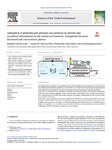Mostrar o rexistro simple do ítem
Adsorption of Pesticides and Personal Care Products on Pristine and Weathered Microplastics in the Marine Environment. Comparison Between Bio-Based and Conventional Plastics
| dc.contributor.author | Concha-Graña, Estefanía | |
| dc.contributor.author | Moscoso Pérez, Carmen María | |
| dc.contributor.author | López-Mahía, P. | |
| dc.contributor.author | Muniategui, Soledad | |
| dc.date.accessioned | 2022-10-18T18:43:48Z | |
| dc.date.available | 2022-10-18T18:43:48Z | |
| dc.date.issued | 2022 | |
| dc.identifier.citation | Estefanía Concha-Graña, Carmen Mª. Moscoso-Pérez, Purificación López-Mahía, Soledad Muniategui-Lorenzo (2022). Adsorption of pesticides and personal care products on pristine and weathered microplastics in the marine environment. Comparison between bio-based and conventional plastics. Science of The Total Environment, Volume 848, 157703. ISSN 0048-9697. https://doi.org/10.1016/j.scitotenv.2022.157703. (https://www.sciencedirect.com/science/article/pii/S0048969722048021) | es_ES |
| dc.identifier.issn | 0048-9697 | |
| dc.identifier.uri | http://hdl.handle.net/2183/31836 | |
| dc.description | Financiado para publicación en acceso aberto: Universidade da Coruña/CISUG | es_ES |
| dc.description.abstract | [Abstract] The hydrophobicity of persistent organic pollutants (POPs) makes them adsorb on microplastics in the marine environment, affecting their distribution, persistence, or their transfer to the trophic chain. Fragrances and non-polar pesticides can be adsorbed by microplastics in the marine environment because of their physico-chemical characteristics. In this work, the adsorption of two pesticides (α-endosulfan and chlorpyrifos) and 6 musk fragrances (musk xylene, musk ketone, musk moskene, galaxolide, tonalide, and celestolide) on polyamide (PA6) (a petroleum based polymer) and on polyhydroxybutyrate (PHB) (biopolymer) in seawater was studied, considering also the effect of water temperature and plastic weathering. Results show higher adsorption of the selected pollutants for PHB than PA, being PA more affected by the water temperature and the plastic weathering. The highest percentage of adsorption was achieved in most cases at 24 h. In addition, this process was irreversible, as it showed the leaching assays. Besides, this work revealed that plastics mitigate the degradation of α-endosulfan in aquatic media (hydrolysis), showing that plastics can act as inhibitors of degradation of POPs, increasing its persistence in the environment. | es_ES |
| dc.description.sponsorship | This work was supported by the Spanish Inter-Ministerial Science and Technology Commission and by the European Union through the European Regional Development Fund (ERDF) through the ARPA-ACUA (CTM2016-77945-C3-3-R) project, and JPI_Oceans 2019 MicroplastiX (PCI2020-112145) and RISBIOPLAS (CHEMPLAS, PID2019-108857RB-C3/AEI/10.13039/501100011033) projects, financed by the Spanish Ministery of Science and Innovation. Financial support is also acknowledged by the Program of Consolidation and Structuring of Units of Competitive Investigation of the University System of Galicia (Xunta de Galicia) potentially co-financed by ERDF in the frame of the operative Program of Galicia 2021–2024 (reference: ED431C 2021/56). Funding for open access charge: Universidade da Coruña/CISUG | es_ES |
| dc.description.sponsorship | Xunta de Galicia; ED431C 2021/56 | es_ES |
| dc.language.iso | eng | es_ES |
| dc.publisher | Elsevier | es_ES |
| dc.relation | info:eu-repo/grantAgreement/AEI/Plan Estatal de Investigación Científica y Técnica y de Innovación 2013-2016/CTM2016-77945-C3-3-R/ES/ALTERNATIVAS AMBIENTALMENTE RESPETUOSAS PARA POLIMEROS Y SUS ADITIVOS QUIMICOS EN MEDIO ACUATICO. SUBPROYECTO DE QUIMICA ANALITICA AMBIENTAL/ | |
| dc.relation | info:eu-repo/grantAgreement/AEI/Plan Estatal de Investigación Científica y Técnica y de Innovación 2017-2020/PCI2020-112145/ES/ENFOQUE INTEGRADO SOBRE EL DESTINO DE MICROPLASTICOS (MPS) HACIA ECOSISTEMAS MARINOS SALUDABLES/ | |
| dc.relation | info:eu-repo/grantAgreement/AEI/Plan Estatal de Investigación Científica y Técnica y de Innovación 2017-2020/PID2019-108857RB-C31/ES/CARACTERIZACION QUIMICA DE POLIMEROS RECICLABLES Y BIOPOLIMEROS Y SUS ADITIVOS (CHEMPLAS)/ | |
| dc.relation.uri | https://doi.org/10.1016/j.scitotenv.2022.157703 | es_ES |
| dc.rights | Atribución 4.0 Internacional (CC BY 4.0) | es_ES |
| dc.rights.uri | https://creativecommons.org/licenses/by/4.0/ | * |
| dc.subject | Polyamide | es_ES |
| dc.subject | Polyhydroxybutyrate | es_ES |
| dc.subject | Sorption | es_ES |
| dc.subject | Leaching | es_ES |
| dc.subject | Musk fragrances | es_ES |
| dc.subject | Pesticides | es_ES |
| dc.title | Adsorption of Pesticides and Personal Care Products on Pristine and Weathered Microplastics in the Marine Environment. Comparison Between Bio-Based and Conventional Plastics | es_ES |
| dc.type | info:eu-repo/semantics/article | es_ES |
| dc.rights.access | info:eu-repo/semantics/openAccess | es_ES |
| UDC.journalTitle | Science of The Total Environment | es_ES |
| UDC.volume | 848 | es_ES |
| UDC.startPage | 157703 | es_ES |
| dc.identifier.doi | 10.1016/j.scitotenv.2022.157703 |
Ficheiros no ítem
Este ítem aparece na(s) seguinte(s) colección(s)
-
GI-QANAP - Artigos [30]






